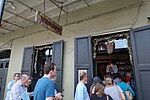Gallier House

Gallier House is a restored 19th-century historic house museum located on Royal Street in the French Quarter of New Orleans, Louisiana. It was originally the home of prominent New Orleans architect, James Gallier Jr. Construction began in 1857 and he moved in with his wife and children in 1860. The fully furnished house includes a courtyard garden, elegant carriageway, and slave quarters. The interior is restored and furnished in the style of the 1850s. The home boasts numerous technological and architectural advancements for its time, offering a glimpse into 19th-century cutting-edge design. It was declared a National Historic Landmark in 1974 for its association with Gallier, one of the city's most important architects of the mid-19th century.In 1996, the Woman's Exchange became the steward of this historic house after acquiring it from Tulane University. The Gallier House reflects an accurate and comprehensive historic restoration of one of New Orleans’ time-honored landmarks.
Excerpt from the Wikipedia article Gallier House (License: CC BY-SA 3.0, Authors, Images).Gallier House
Ursulines Avenue, New Orleans French Quarter
Geographical coordinates (GPS) Address Nearby Places Show on map
Geographical coordinates (GPS)
| Latitude | Longitude |
|---|---|
| N 29.961322222222 ° | E -90.061391666667 ° |
Address
Ursulines Avenue 627
70116 New Orleans, French Quarter
Louisiana, United States
Open on Google Maps









